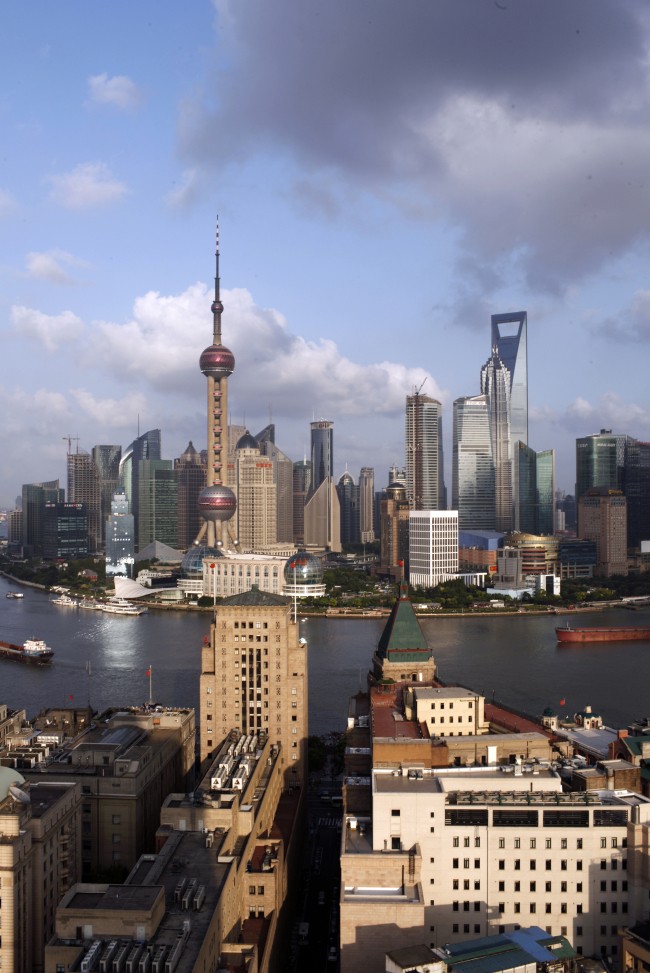 |
The historic Bund sits in the foreground with the Lujiazui financial district on the other side of the Huangpu river in Shanghai. (Bloomberg) |
China’s plan for a free trade zone in Shanghai is “very positive” and will help improve the country’s competitiveness, World Bank President Jim Yong Kim said.
“Every single country in the world is trying to become competitive and I think this free trade zone will allow China to become more competitive,” Kim said at a briefing in Shanghai Sunday at the start of a four-day visit. The government is committed to financial and fiscal policy reforms which will pave the way for long-term expansion, he said.
Premier Li Keqiang will this month officiate at an opening ceremony for the zone which will test economic and financial changes including interest-rate liberalization, Bloomberg News reported on Friday, citing two people with knowledge of the matter. China may see the weakest expansion in 23 years this year and Li warned last week that the country will fail to achieve sustained growth unless it restructures the economy.
“These kinds of financial sector reforms can be difficult, but they are critical,” Kim said. “We want to be as supportive as we can be of the government in tackling these kinds of difficult financial sector reforms even in a time when growth is slowing.”
China’s economy expanded 7.7 percent last year, the least since 1999, and the pace may weaken to 7.5 percent this year, according to the median estimate in a Bloomberg News survey in August. That would be the slowest rate since 1990 and match the government’s target set in March.
Chinese leaders are seeking to maintain confidence in the economy. President Xi Jinping said this month the government chose to bring down the growth rate to solve “fundamental problems” hindering long-run development. Speaking in Dalian on Sept. 11, Li said China will focus on shifting its growth model while ensuring economic expansion remains within a “reasonable range.”
“Everyone in the world is looking at Chinese growth numbers,” Kim said Sunday. “The fact the government is saying, well, it’s a little bit slower, but we are committed to quality, we are committed to reforms we need to take, I think is a cause for great optimism for long term growth.”
China’s State Council, headed by Li, approved the Shanghai free trade zone in July. While no detailed policies have yet been released, a draft plan seen by Bloomberg News included expanded opportunities for foreign companies in industries from banking to health insurance.
HSBC Holdings Plc, Mizuho Securities Asia Ltd. and Standard Chartered Bank Plc say the zone will also test interest-rate liberalization and freer yuan convertibility, and promote development of services industries. An opening ceremony will take place on a day from Sept. 27 to 29, depending on Li’s schedule, two people with knowledge of the matter said last week.
The focus of Kim’s visit to China from Sept. 15 to 18 is climate change, according to a World Bank statement last week. While in Shanghai, he was scheduled to visit projects that are helping the city shift to a low-carbon growth model, it said.
The World Bank is working with China on a broad climate-change agenda that includes promoting clean energy, reducing traffic jams and air pollution and improving flood risk management, Kim said at Sunday’s briefing. China is the world’s largest carbon-dioxide emitter and biggest coal user.
The State Council last week released a plan to reduce coal consumption, close steel plants and control the number of cars on its roads to “gradually eliminate” heavily polluted days within a decade. The proposals flesh out Li’s pledge in March to clean up pollution after concentrations of PM2.5, the most-damaging particulate matter, soared to almost 40 times the World Health Organization’s recommended level in Beijing in January.
Kim will also visit Beijing for meetings with state leaders which will include discussions on China’s urbanization challenges, according to the World Bank’s Sept. 12 statement that didn’t name the officials.
Li last year asked the World Bank and the State Council’s Development Research Center to work on a joint study to develop a new model of urbanization for China. Li, who was vice premier at the time, asked for the research to help form his own strategic approach to urbanization, Kim said at a briefing in November.
The report is still being prepared and will be published in December, Kim said Sunday.
The World Bank and the DRC released a 448-page report last year titled “China 2030,” which was conceived to help China avoid the middle-income trap. The term refers to a situation where the pace of productivity gains and growth decelerates sharply, as an economy classified by the lender as “middle income” fails to carry out reforms and upgrade its industrial structure, preventing its rise to “high income” status.
Li has championed urbanization as a “huge engine” for growth as he seeks to shift the world’s second-largest economy toward a model that relies on consumption rather than investment and exports. Policy makers are drafting plans to implement the strategy ahead of a key Communist Party meeting later this year. (Bloomberg)








